1998 DODGE RAM 1500 Washer
[x] Cancel search: WasherPage 1720 of 2627

Inspect output shaft bearing retainer, the
U-shaped retainer must be flat and free of distortion.
Replace the retainer if the threads are damaged or if
the retainer is bent or cracked.
COUNTERSHAFT BEARINGS AND RACES
The countershaft bearings and races are machine
lapped during manufacture to form matched sets.
The bearings and races should not be interchanged.
NOTE: The bearing races are a permanent press fit
in the housings and are NOT serviceable. If a bear-
ing race becomes damaged, the front or rear hous-
ing must be replaced. A new countershaft bearing
will be supplied with each new housing for service
use.
REVERSE IDLER COMPONENTS
Inspect the idler gear, bearing, shaft, thrust
washer, wave washer and thrust plate. Replace the
bearing if any of the needle bearing rollers are worn,
chipped, cracked, flat-spotted or brinnelled. Also
replace the bearing if the plastic bearing cage is
damaged or distorted.
Replace thrust washer, wave washer or thrust
plate if cracked, chipped or worn. Replace idler gear
if the teeth are chipped, cracked or worn thin.
Replace shaft if worn, scored or the bolt threads are
damaged beyond repair. Replace support segment if
cracked or chipped and replace the idler attaching
bolts if the threads are damaged.
Shift Socket
Inspect the shift socket for wear or damage.
Replace the socket if the roll pin or shift shaft bores
are damaged. Minor nicks in the shift lever ball seat
in the socket can be smoothed down with 400 grit
emery or wet/dry paper. Replace the socket if the ball
seat is worn or cracked. Do not reuse the original
shift socket roll pin. Install anewpin during assem-
bly. The socket roll pin is approximately 33 mm
(1-1/4 in.) long.
Output Shaft And Geartrain
Inspect all gears for worn, cracked, chipped or bro-
ken teeth. Also check condition of the bearing bore in
each gear. The bores should be smooth and free of
surface damage. Discoloration of the gear bores is a
normal occurrence and is not a reason for replace-
ment. Replace gears only when tooth damage has
occurred or if the bores are brinnelled or severely
scored.
Inspect the shaft splines and bearings surfaces.
Minor nicks on the bearing surfaces can be smoothed
with 320/420 grit emery and final polished with cro-
cus cloth. Replace the shaft if the splines are dam-aged or bearing surfaces are deeply scored, worn or
brinnelled.
ASSEMBLY
NOTE: Sealers are used at all case joints. Use
Mopar Gasket Maker or equivalent for all case joints
and Mopar silicone sealer or equivalent for the
input shaft bearing retainer.
SYNCHRONIZER
(1) Slide sleeve onto the hub, leaving enough room
to install the spring in the hub and strut in the hub
groove.
(2) Install first spring in the hub, then install a
strut over the spring. Verify spring is seated in the
spring bore in the strut.
(3) Slide sleeve onto the hub far enough to hold
the first strut and spring in place.
(4) Place detent ball in the top of the strut, then
press the ball into place with a small screwdriver.
Work the sleeve over the ball to hold it in place.
(5) Repeat procedure for the remaining springs,
struts and balls. Use tape or rubber bands to tempo-
rarily secure each strut and ball as they are
installed.
(6) Verify the synchro three springs, struts and
detent balls are all in place (Fig. 49).
Fig. 49 SYNCHRONIZER COMPONENTS
1 - SLEEVE
2 - HUB SHOULDER
3 - SPRING (3)
4 - STRUT (3)
5 - DETENT BALL (3)
6 - HUB
DRMANUAL TRANSMISSION - NV3500 21 - 17
MANUAL TRANSMISSION - NV3500 (Continued)
Page 1725 of 2627
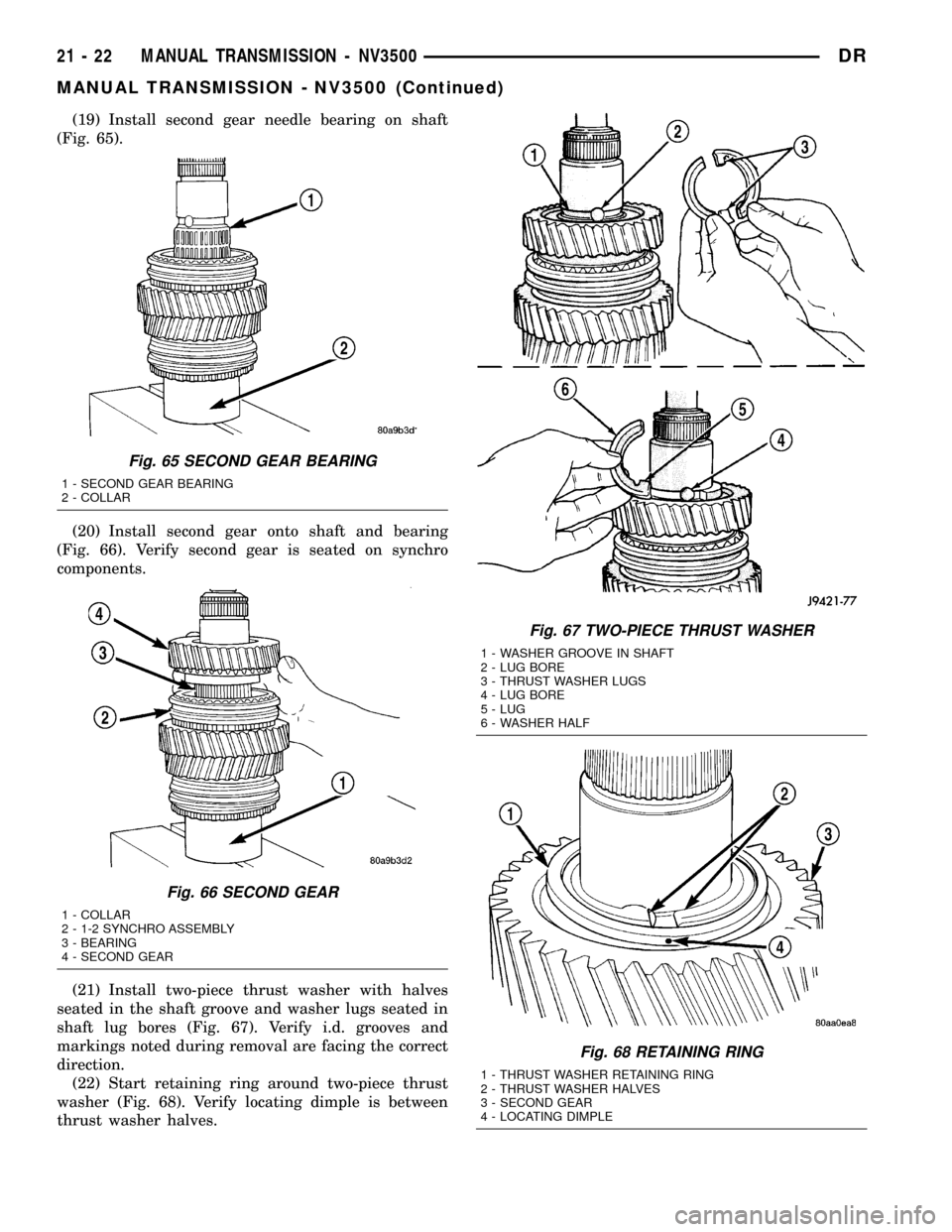
(19) Install second gear needle bearing on shaft
(Fig. 65).
(20) Install second gear onto shaft and bearing
(Fig. 66). Verify second gear is seated on synchro
components.
(21) Install two-piece thrust washer with halves
seated in the shaft groove and washer lugs seated in
shaft lug bores (Fig. 67). Verify i.d. grooves and
markings noted during removal are facing the correct
direction.
(22) Start retaining ring around two-piece thrust
washer (Fig. 68). Verify locating dimple is between
thrust washer halves.
Fig. 65 SECOND GEAR BEARING
1 - SECOND GEAR BEARING
2 - COLLAR
Fig. 66 SECOND GEAR
1 - COLLAR
2 - 1-2 SYNCHRO ASSEMBLY
3 - BEARING
4 - SECOND GEAR
Fig. 67 TWO-PIECE THRUST WASHER
1 - WASHER GROOVE IN SHAFT
2 - LUG BORE
3 - THRUST WASHER LUGS
4 - LUG BORE
5 - LUG
6 - WASHER HALF
Fig. 68 RETAINING RING
1 - THRUST WASHER RETAINING RING
2 - THRUST WASHER HALVES
3 - SECOND GEAR
4 - LOCATING DIMPLE
21 - 22 MANUAL TRANSMISSION - NV3500DR
MANUAL TRANSMISSION - NV3500 (Continued)
Page 1726 of 2627
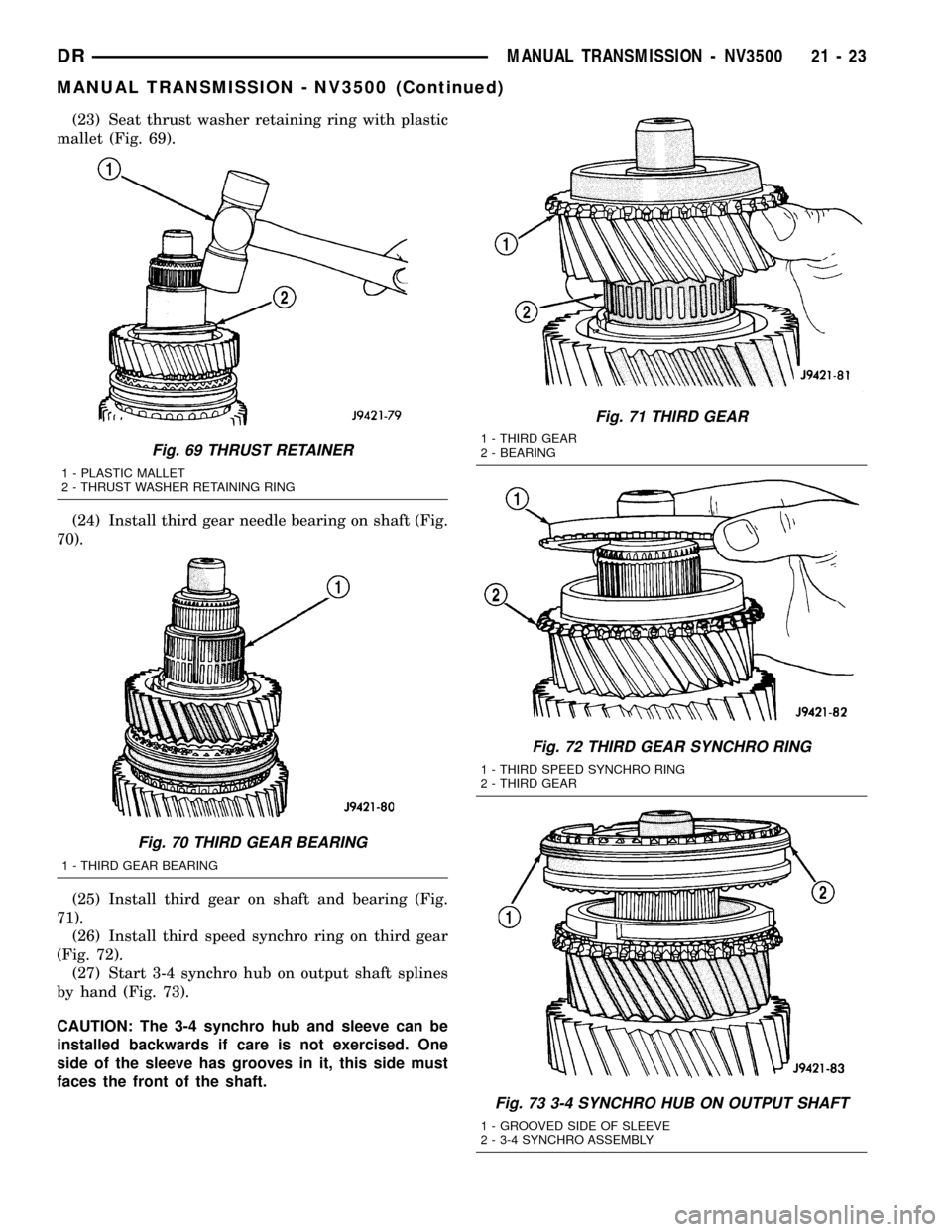
(23) Seat thrust washer retaining ring with plastic
mallet (Fig. 69).
(24) Install third gear needle bearing on shaft (Fig.
70).
(25) Install third gear on shaft and bearing (Fig.
71).
(26) Install third speed synchro ring on third gear
(Fig. 72).
(27) Start 3-4 synchro hub on output shaft splines
by hand (Fig. 73).
CAUTION: The 3-4 synchro hub and sleeve can be
installed backwards if care is not exercised. One
side of the sleeve has grooves in it, this side must
faces the front of the shaft.
Fig. 69 THRUST RETAINER
1 - PLASTIC MALLET
2 - THRUST WASHER RETAINING RING
Fig. 70 THIRD GEAR BEARING
1 - THIRD GEAR BEARING
Fig. 71 THIRD GEAR
1 - THIRD GEAR
2 - BEARING
Fig. 72 THIRD GEAR SYNCHRO RING
1 - THIRD SPEED SYNCHRO RING
2 - THIRD GEAR
Fig. 73 3-4 SYNCHRO HUB ON OUTPUT SHAFT
1 - GROOVED SIDE OF SLEEVE
2 - 3-4 SYNCHRO ASSEMBLY
DRMANUAL TRANSMISSION - NV3500 21 - 23
MANUAL TRANSMISSION - NV3500 (Continued)
Page 1727 of 2627
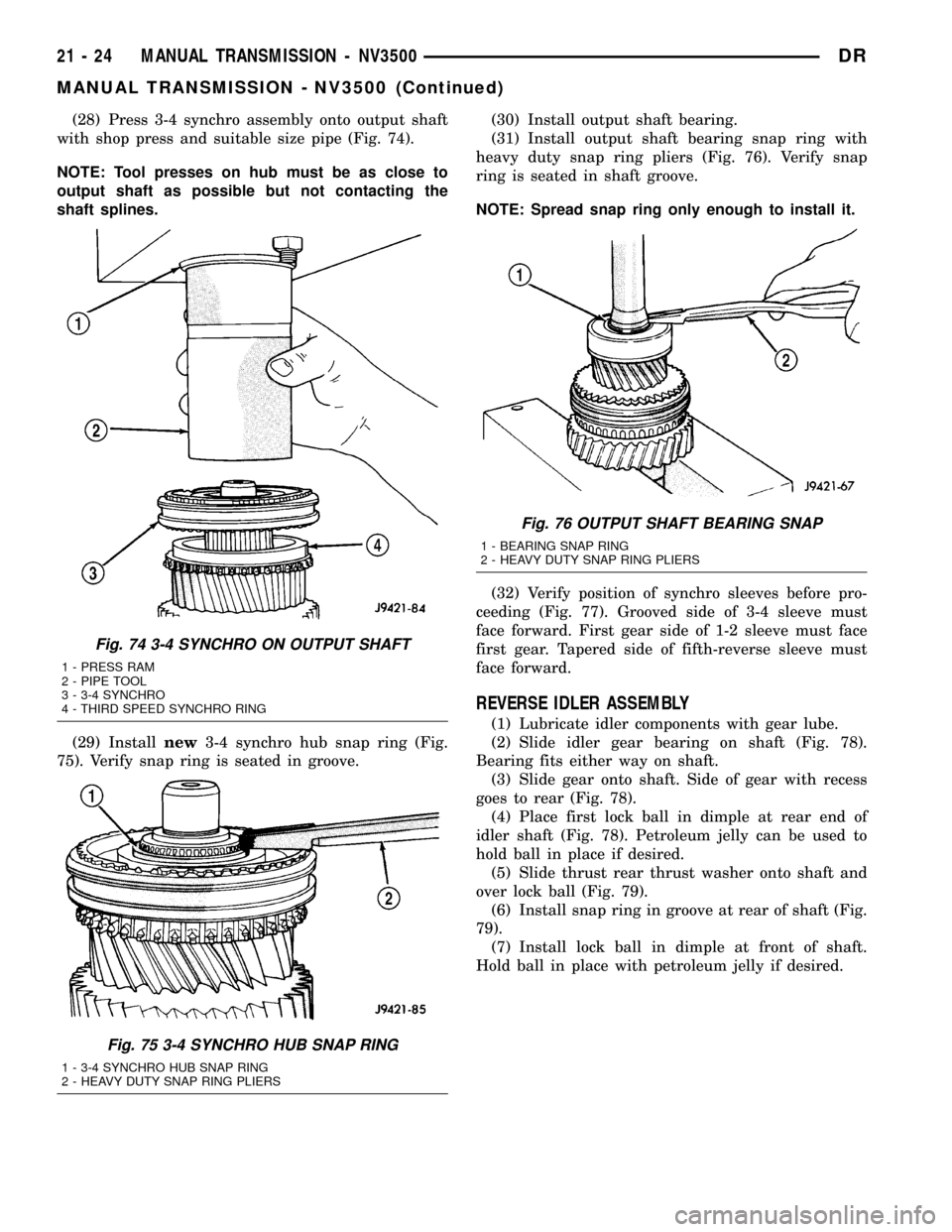
(28) Press 3-4 synchro assembly onto output shaft
with shop press and suitable size pipe (Fig. 74).
NOTE: Tool presses on hub must be as close to
output shaft as possible but not contacting the
shaft splines.
(29) Installnew3-4 synchro hub snap ring (Fig.
75). Verify snap ring is seated in groove.(30) Install output shaft bearing.
(31) Install output shaft bearing snap ring with
heavy duty snap ring pliers (Fig. 76). Verify snap
ring is seated in shaft groove.
NOTE: Spread snap ring only enough to install it.
(32) Verify position of synchro sleeves before pro-
ceeding (Fig. 77). Grooved side of 3-4 sleeve must
face forward. First gear side of 1-2 sleeve must face
first gear. Tapered side of fifth-reverse sleeve must
face forward.
REVERSE IDLER ASSEMBLY
(1) Lubricate idler components with gear lube.
(2) Slide idler gear bearing on shaft (Fig. 78).
Bearing fits either way on shaft.
(3) Slide gear onto shaft. Side of gear with recess
goes to rear (Fig. 78).
(4) Place first lock ball in dimple at rear end of
idler shaft (Fig. 78). Petroleum jelly can be used to
hold ball in place if desired.
(5) Slide thrust rear thrust washer onto shaft and
over lock ball (Fig. 79).
(6) Install snap ring in groove at rear of shaft (Fig.
79).
(7) Install lock ball in dimple at front of shaft.
Hold ball in place with petroleum jelly if desired.
Fig. 74 3-4 SYNCHRO ON OUTPUT SHAFT
1 - PRESS RAM
2 - PIPE TOOL
3 - 3-4 SYNCHRO
4 - THIRD SPEED SYNCHRO RING
Fig. 75 3-4 SYNCHRO HUB SNAP RING
1 - 3-4 SYNCHRO HUB SNAP RING
2 - HEAVY DUTY SNAP RING PLIERS
Fig. 76 OUTPUT SHAFT BEARING SNAP
1 - BEARING SNAP RING
2 - HEAVY DUTY SNAP RING PLIERS
21 - 24 MANUAL TRANSMISSION - NV3500DR
MANUAL TRANSMISSION - NV3500 (Continued)
Page 1728 of 2627
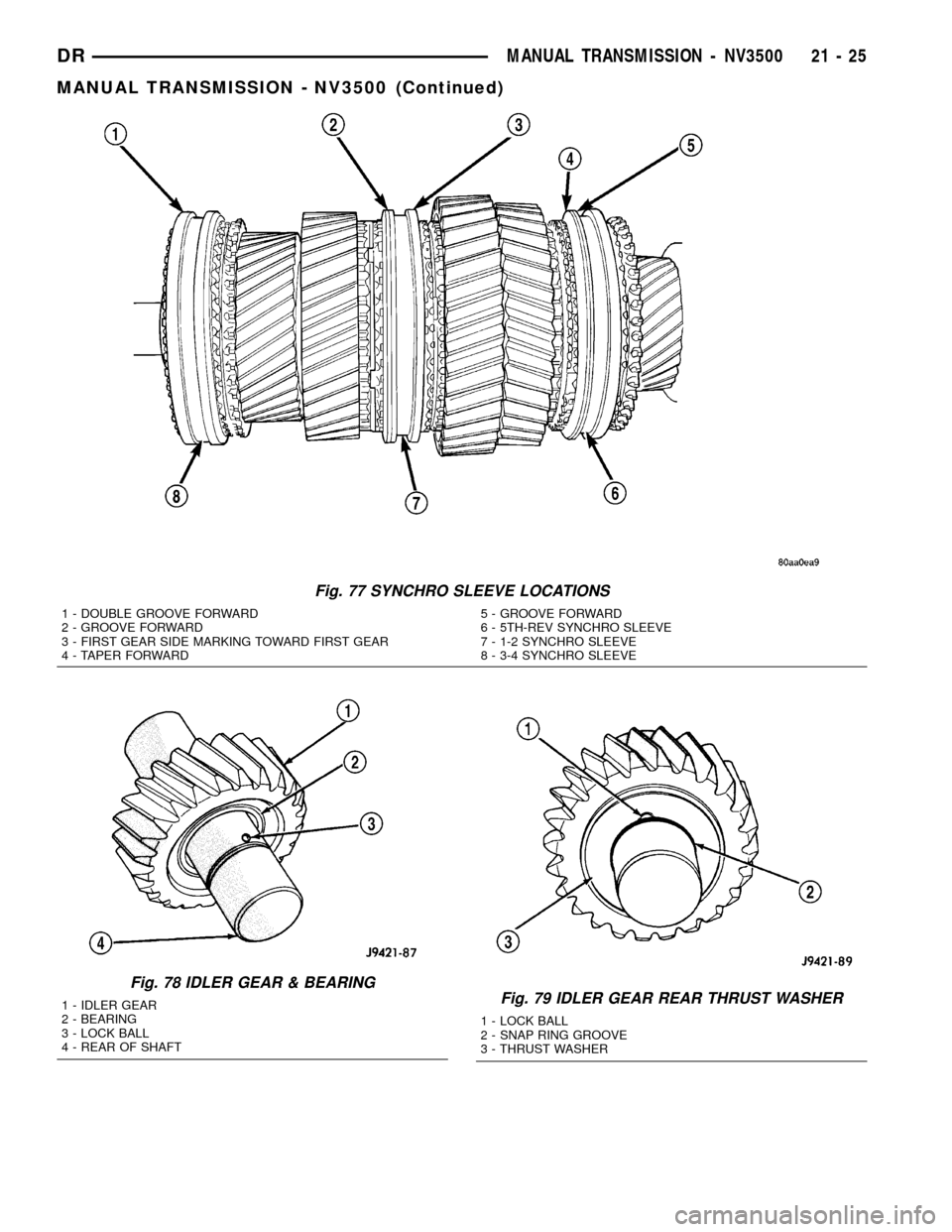
Fig. 77 SYNCHRO SLEEVE LOCATIONS
1 - DOUBLE GROOVE FORWARD
2 - GROOVE FORWARD
3 - FIRST GEAR SIDE MARKING TOWARD FIRST GEAR
4 - TAPER FORWARD5 - GROOVE FORWARD
6 - 5TH-REV SYNCHRO SLEEVE
7 - 1-2 SYNCHRO SLEEVE
8 - 3-4 SYNCHRO SLEEVE
Fig. 78 IDLER GEAR & BEARING
1 - IDLER GEAR
2 - BEARING
3 - LOCK BALL
4 - REAR OF SHAFTFig. 79 IDLER GEAR REAR THRUST WASHER
1 - LOCK BALL
2 - SNAP RING GROOVE
3 - THRUST WASHER
DRMANUAL TRANSMISSION - NV3500 21 - 25
MANUAL TRANSMISSION - NV3500 (Continued)
Page 1729 of 2627

(8) Install front thrust washer on shaft and slide
washer up against gear and over lock ball (Fig. 80).
(9) Install wave washer, flat washer and remain-
ing snap ring on idler shaft (Fig. 80). Verify snap
ring is seated.
SHIFT SHAFT AND DETENT PLUNGER BUSHINGS/
BEARINGS
(1) Inspect shift shaft bushing and bearing for
damage.
(2) If necessary, the shift shaft bushing can be
replaced as follows:
(a) Locate a bolt that will thread into the bush-
ing without great effort.
(b) Thread the bolt into the bushing, allowing
the bolt to make its own threads in the bushing.
(c) Attach a slide hammer or suitable puller to
the bolt and remove bushing.(d) Use the short end of Installer 8119 to install
the new bushing.
(e) Bushing is correctly installed if flush with
the transmission case.
(3) If necessary, the shift shaft bearing can be
replaced as follows:
(a) Locate a bolt that will thread into the bear-
ing without great effort.
(b) Thread the bolt into the bearing as much as
possible.
(c) Attach a slide hammer or suitable puller to
the bolt and remove the bearing.
(d) Use the short end of Installer 8119 to install
the new bearing.
(e) Bearing is correctly installed if flush with the
transmission case.
(4) Inspect detent plunger bushings for damage.
NOTE: The detent plunger bushings are installed to
a specific depth. The space between the two bush-
ings when correctly installed contain an oil feed
hole. Do not attempt to install the bushings with
anything other than the specified tool or this oil
hole may become restricted.
(5) If necessary, the detent plunger bushings can
be replaced as follows:
(a) Using the long end of Installer 8119, drive
the detent bushings through the outer case and
into the shift shaft bore.
(b) Remove the bushings from the shift shaft
bore.
(c) Install a new detent plunger bushing on the
long end of Installer 8118.
(d) Start bushing in the detent plunger bore in
the case.
(e) Drive bushing into the bore until the tool
contacts the transmission case.
(f) Install a new detent plunger bushing on the
short end of Installer 8118.
(g) Start the bushing in the detent plunger bore
in the case.
(h) Drive bushing into the bore until the tool
contacts the transmission case.
Fig. 80 IDLER GEAR & SHAFT ASSEMBLY
1 - REAR OF SHAFT
2 - GEAR
3 - THRUST WASHER AND BALL
4 - WAVE WASHER
5 - FLAT WASHER
6 - FRONT OF SHAFT
7 - SNAP RING
8 - SNAP RING
21 - 26 MANUAL TRANSMISSION - NV3500DR
MANUAL TRANSMISSION - NV3500 (Continued)
Page 1742 of 2627
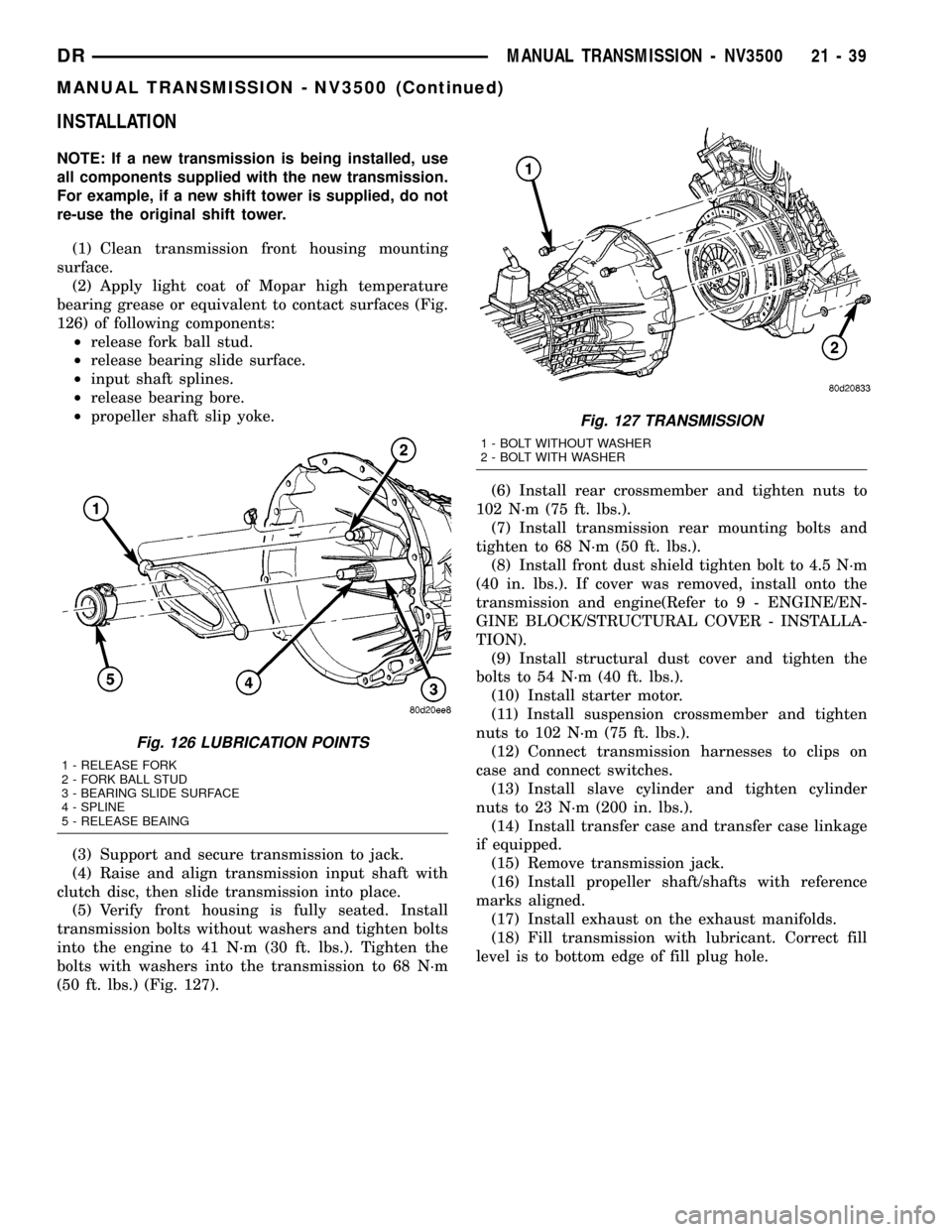
INSTALLATION
NOTE: If a new transmission is being installed, use
all components supplied with the new transmission.
For example, if a new shift tower is supplied, do not
re-use the original shift tower.
(1) Clean transmission front housing mounting
surface.
(2) Apply light coat of Mopar high temperature
bearing grease or equivalent to contact surfaces (Fig.
126) of following components:
²release fork ball stud.
²release bearing slide surface.
²input shaft splines.
²release bearing bore.
²propeller shaft slip yoke.
(3) Support and secure transmission to jack.
(4) Raise and align transmission input shaft with
clutch disc, then slide transmission into place.
(5) Verify front housing is fully seated. Install
transmission bolts without washers and tighten bolts
into the engine to 41 N´m (30 ft. lbs.). Tighten the
bolts with washers into the transmission to 68 N´m
(50 ft. lbs.) (Fig. 127).(6) Install rear crossmember and tighten nuts to
102 N´m (75 ft. lbs.).
(7) Install transmission rear mounting bolts and
tighten to 68 N´m (50 ft. lbs.).
(8) Install front dust shield tighten bolt to 4.5 N´m
(40 in. lbs.). If cover was removed, install onto the
transmission and engine(Refer to 9 - ENGINE/EN-
GINE BLOCK/STRUCTURAL COVER - INSTALLA-
TION).
(9) Install structural dust cover and tighten the
bolts to 54 N´m (40 ft. lbs.).
(10) Install starter motor.
(11) Install suspension crossmember and tighten
nuts to 102 N´m (75 ft. lbs.).
(12) Connect transmission harnesses to clips on
case and connect switches.
(13) Install slave cylinder and tighten cylinder
nuts to 23 N´m (200 in. lbs.).
(14) Install transfer case and transfer case linkage
if equipped.
(15) Remove transmission jack.
(16) Install propeller shaft/shafts with reference
marks aligned.
(17) Install exhaust on the exhaust manifolds.
(18) Fill transmission with lubricant. Correct fill
level is to bottom edge of fill plug hole.
Fig. 126 LUBRICATION POINTS
1 - RELEASE FORK
2 - FORK BALL STUD
3 - BEARING SLIDE SURFACE
4 - SPLINE
5 - RELEASE BEAING
Fig. 127 TRANSMISSION
1 - BOLT WITHOUT WASHER
2 - BOLT WITH WASHER
DRMANUAL TRANSMISSION - NV3500 21 - 39
MANUAL TRANSMISSION - NV3500 (Continued)
Page 1750 of 2627
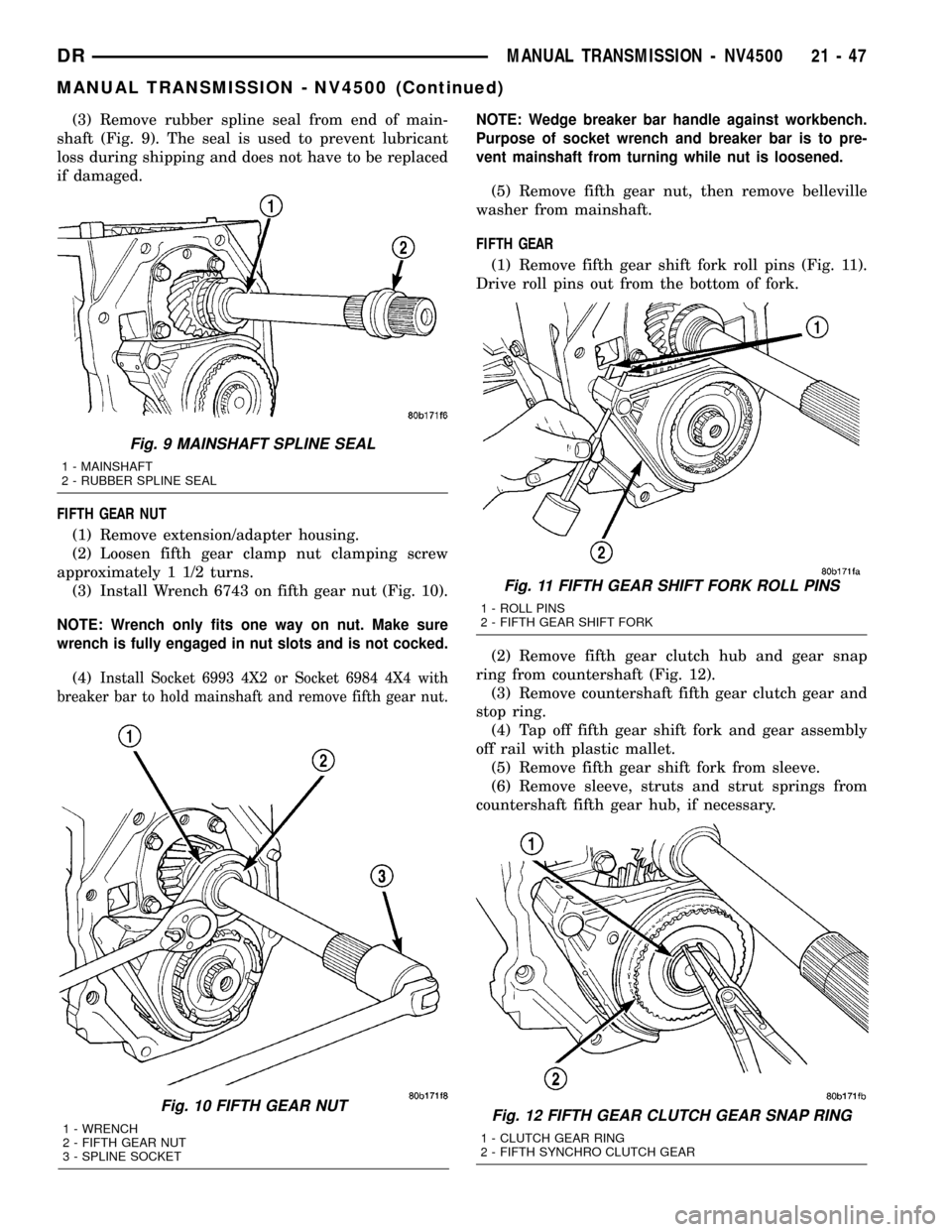
(3) Remove rubber spline seal from end of main-
shaft (Fig. 9). The seal is used to prevent lubricant
loss during shipping and does not have to be replaced
if damaged.
FIFTH GEAR NUT
(1) Remove extension/adapter housing.
(2) Loosen fifth gear clamp nut clamping screw
approximately 1 1/2 turns.
(3) Install Wrench 6743 on fifth gear nut (Fig. 10).
NOTE: Wrench only fits one way on nut. Make sure
wrench is fully engaged in nut slots and is not cocked.
(4)Install Socket 6993 4X2 or Socket 6984 4X4 with
breaker bar to hold mainshaft and remove fifth gear nut.
NOTE: Wedge breaker bar handle against workbench.
Purpose of socket wrench and breaker bar is to pre-
vent mainshaft from turning while nut is loosened.
(5) Remove fifth gear nut, then remove belleville
washer from mainshaft.
FIFTH GEAR
(1) Remove fifth gear shift fork roll pins (Fig. 11).
Drive roll pins out from the bottom of fork.
(2) Remove fifth gear clutch hub and gear snap
ring from countershaft (Fig. 12).
(3) Remove countershaft fifth gear clutch gear and
stop ring.
(4) Tap off fifth gear shift fork and gear assembly
off rail with plastic mallet.
(5) Remove fifth gear shift fork from sleeve.
(6) Remove sleeve, struts and strut springs from
countershaft fifth gear hub, if necessary.
Fig. 10 FIFTH GEAR NUT
1 - WRENCH
2 - FIFTH GEAR NUT
3 - SPLINE SOCKET
Fig. 9 MAINSHAFT SPLINE SEAL
1 - MAINSHAFT
2 - RUBBER SPLINE SEAL
Fig. 11 FIFTH GEAR SHIFT FORK ROLL PINS
1 - ROLL PINS
2 - FIFTH GEAR SHIFT FORK
Fig. 12 FIFTH GEAR CLUTCH GEAR SNAP RING
1 - CLUTCH GEAR RING
2 - FIFTH SYNCHRO CLUTCH GEAR
DRMANUAL TRANSMISSION - NV4500 21 - 47
MANUAL TRANSMISSION - NV4500 (Continued)